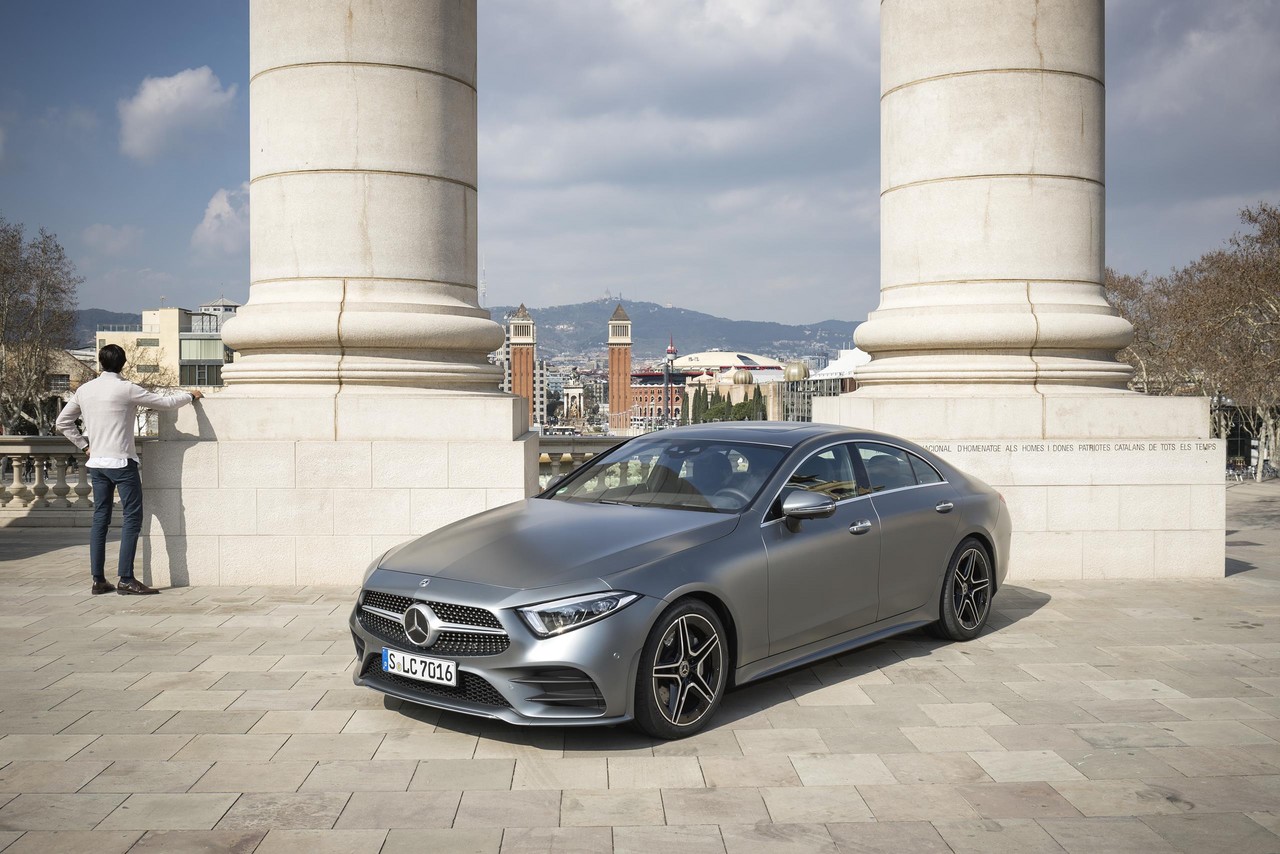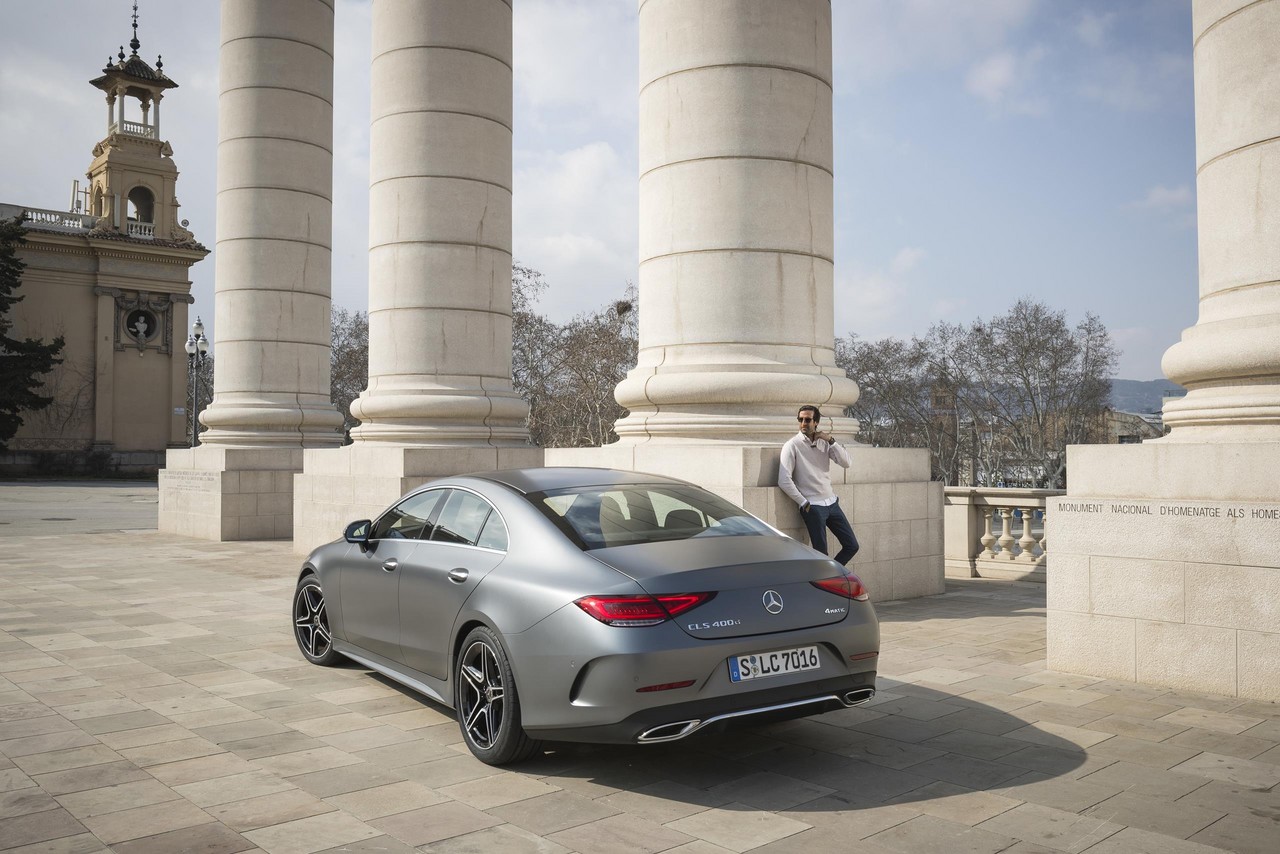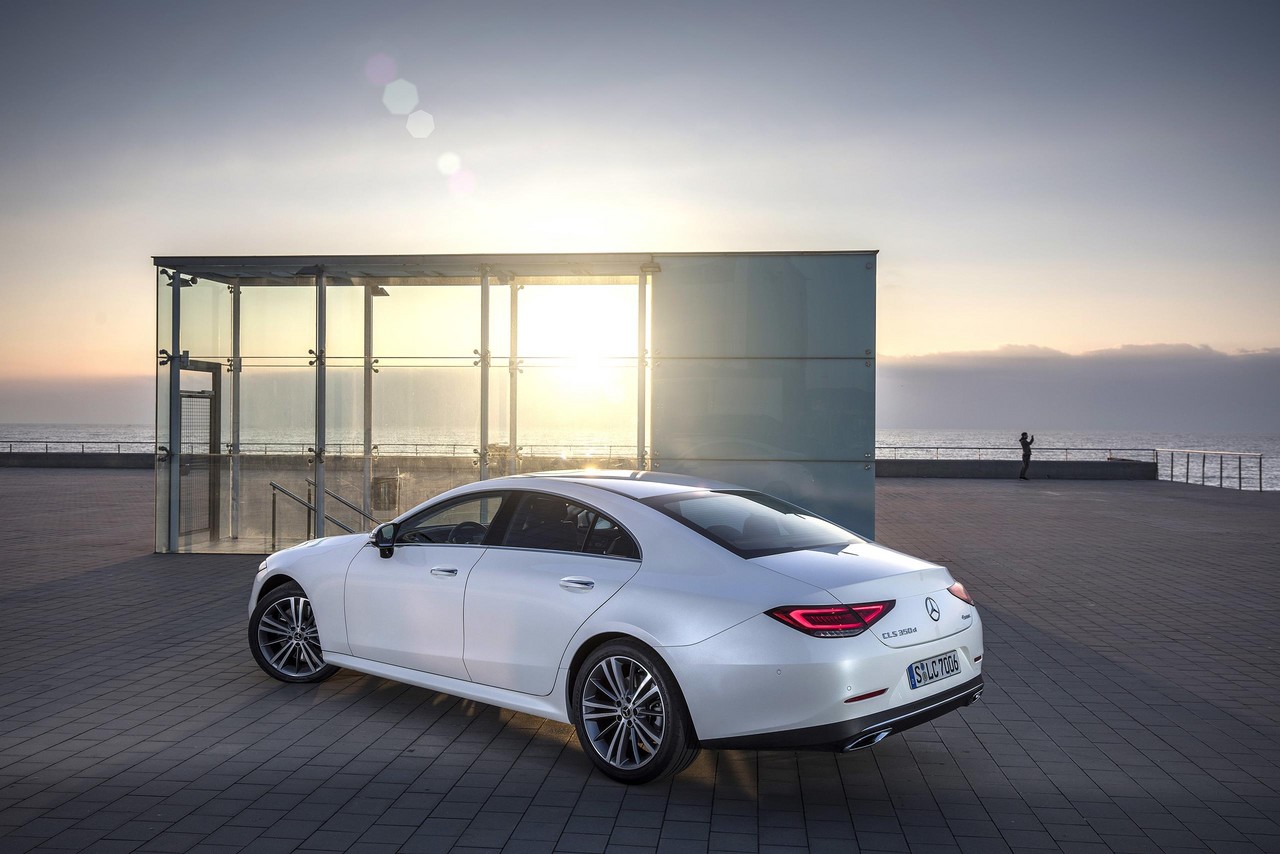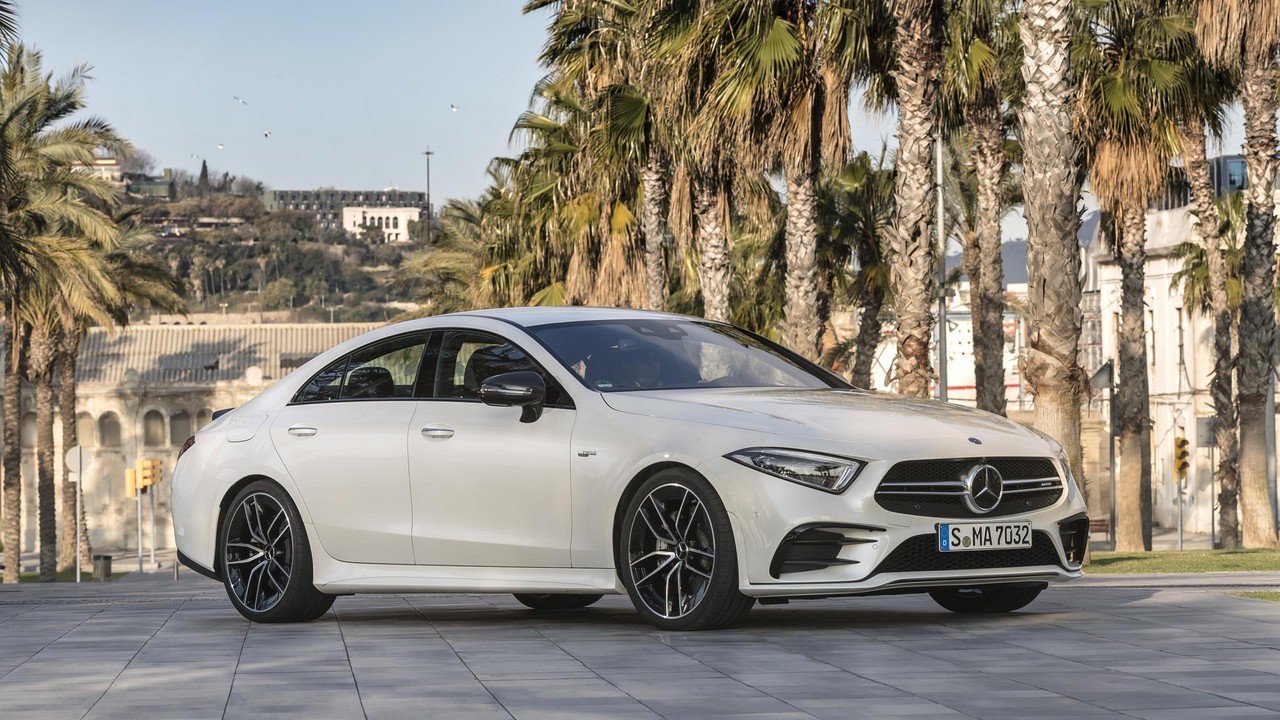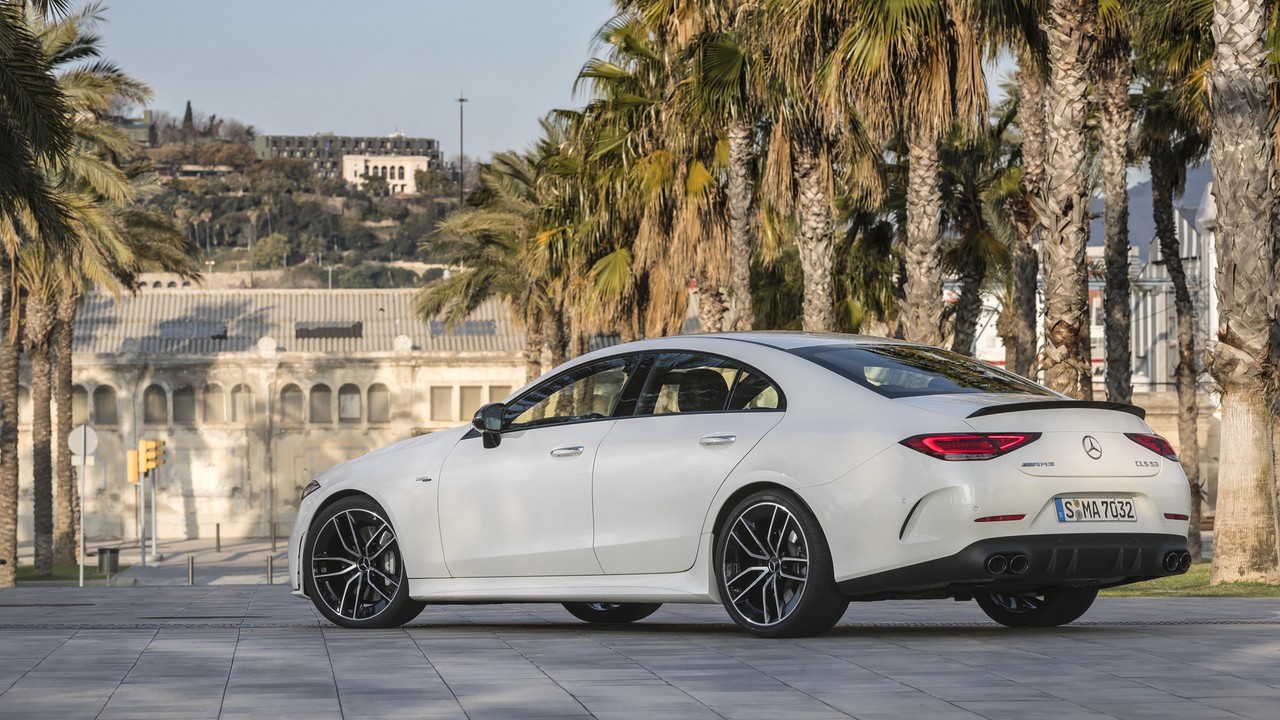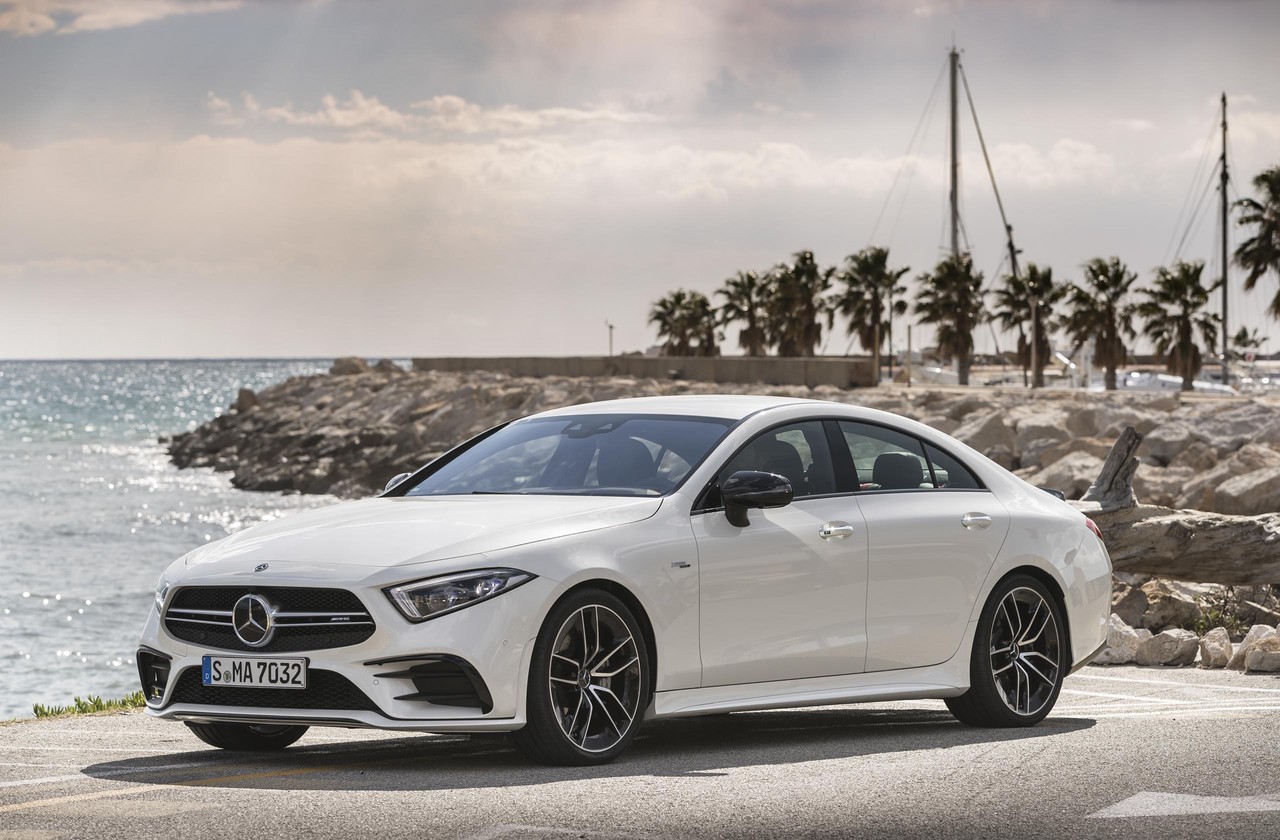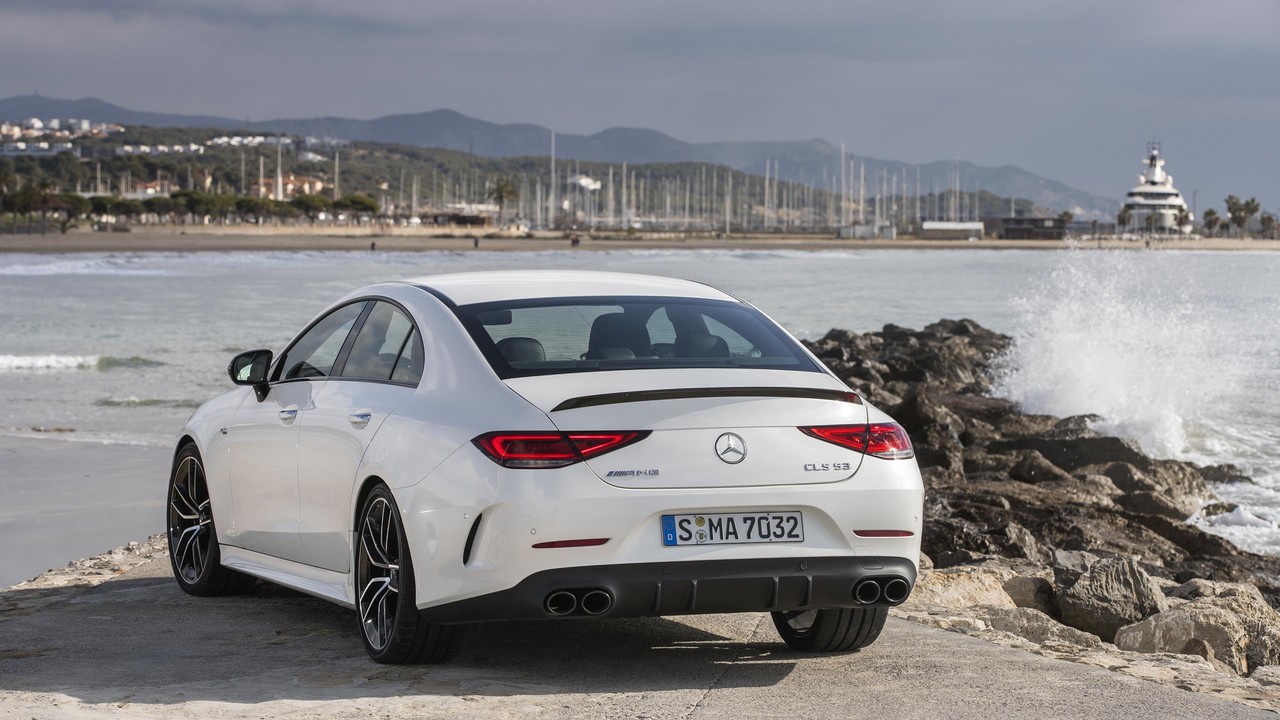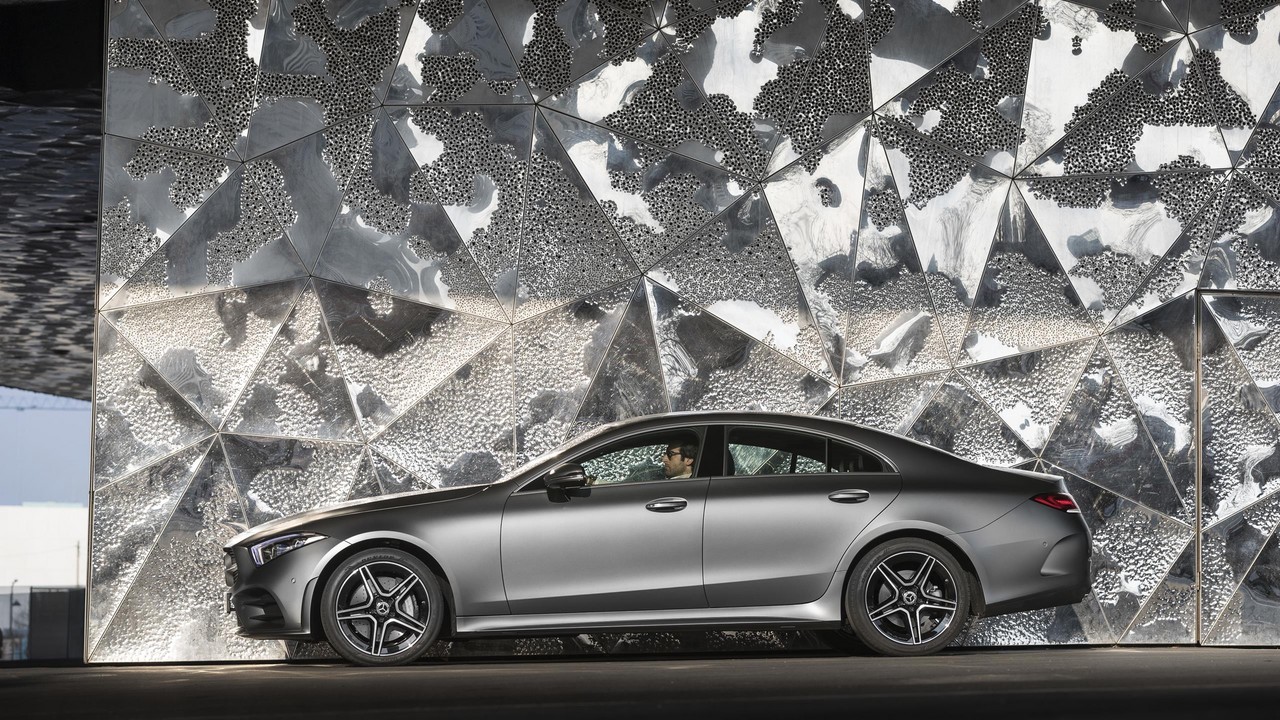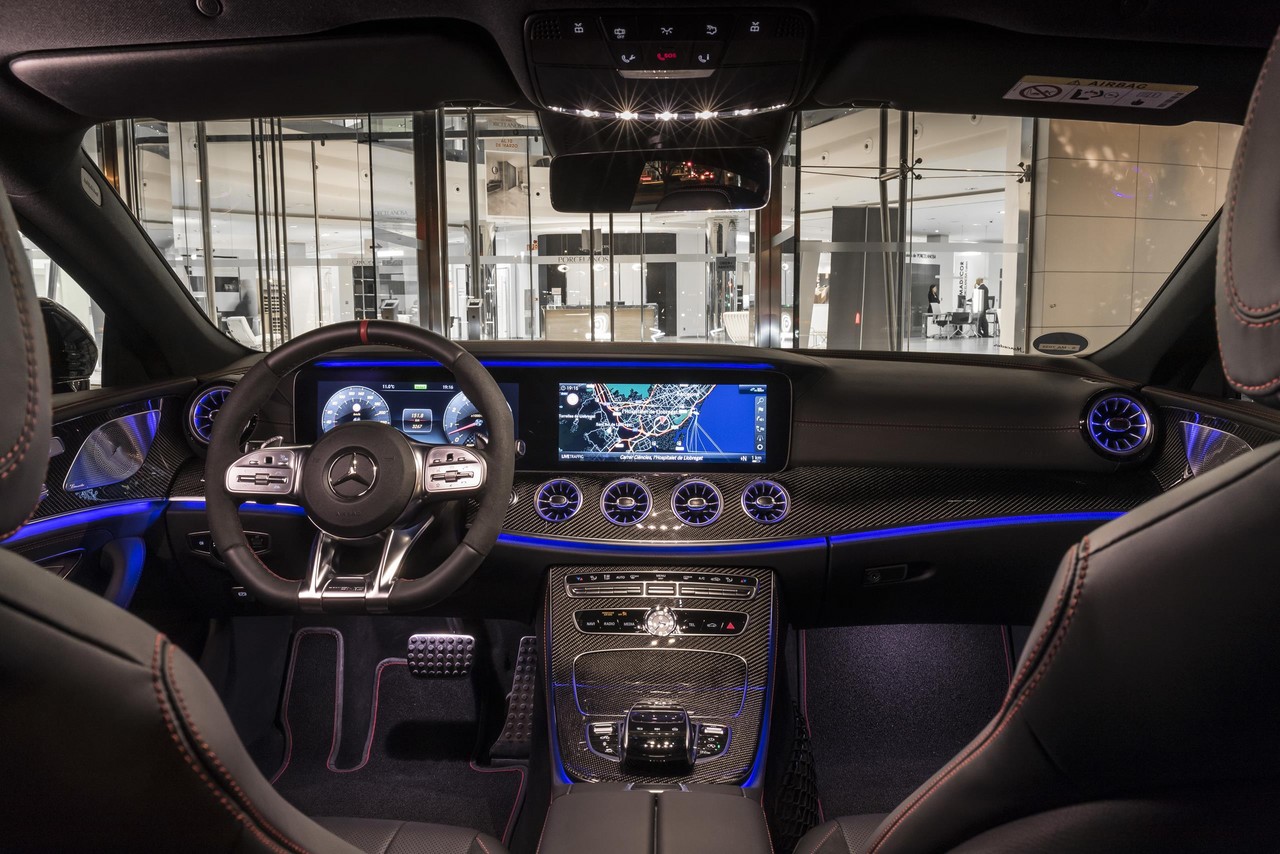
- Array of active safety technologies
- Performance of turbocharged M256 engine
- Comfortable ride on 18-inch wheels
- Well-weighted steering
- Why is an ‘Acoustic Comfort’ sound insulation optional?
- Steering feedback?
- Body control from standard steel suspension?
- Rear seat space and headroom?
- Diesel engine noise?
Overview
Released in Australia in July 2018, the Mercedes-Benz C257 CLS was a four-door, five-seat sedan with a coupe-like profile. Manufactured in Sindelfingen, Germany, the Mercedes-Benz C257 CLS range for Australia consisted of the CLS 350, CLS 450 4MATIC and CLS 53 4MATIC+.
For the CLS 450 4MATIC and CLS 53 4MATIC+, the M256 petrol engine was combined with an ‘EQ Boost’ integrated starter/generator that produced 16 kW and 250 Nm. Using a 48 volt electrical system, EQ Boost could assist the petrol engine when accelerating and enabled the vehicle to coast or ‘sail’ without the operation of the petrol engine. The generator could also supply the battery with power through its energy recuperation function. Whereas the M256 engine for the CLS 450 had a single turbocharger, the M256 engine for the CLS 53 has two turbochargers and an electric auxiliary compressor.
| Engine | Trans. | Peak power | Peak torque | |
|---|---|---|---|---|
| CLS 350 | 1996 cc M264 turbo petrol I4 | 9sp auto | 220 kW at 5800-6100 rpm | 400 Nm at 3000-4000 rpm |
| Electric motor | ||||
| CLS 450 4MATIC | 2999 cc M256 turbo petrol I6 | 9sp auto | 270 kW at 5500-6100 rpm | 500 Nm at 1600-4000 rpm |
| Electric motor | 16 kW | 250 Nm | ||
| CLS 53 4MATIC+ | 2999 cc M256 turbo petrol I6 | 9sp auto | 320 kW at 6100 rpm | 520 Nm at 1800-5800 rpm |
| Electric motor | 16 kW | 250 Nm |
4MATIC and 4MATIC+ all-wheel drive systems
The ‘4MATIC’ all-wheel drive system distributed torque in a default 45:55 front:rear split. If one or more wheels lost grip, however, the four-wheel traction system (‘4ETS’) would brake that wheel/s to divert drive power to the wheels with traction. The 4MATIC system also had a ‘pre-lock clutch’, a double-disc clutch that was fitted to the centre differential and provided a basic locking torque of approximately 50 Nm between the front and rear axles. The clutch pack was permanently pre-loaded via a plate spring and, in the event of a spinning wheel, friction torque was transmitted to the axle which rotated more slowly by the relative movement of the discs – this ‘variable torque shift’ improved traction and directional stability.
For the Mercedes-AMG CLS 53, the 4MATIC+ system had an electro-mechanically controlled clutch that connected the permanently driven rear axle to the front axle. As such, torque distribution to the front axle depended on the operation of the clutch, which was based on driving conditions and driver behaviour.
Body and dimensions
The Mercedes-Benz C257 CLS shared its platform with the W213 E-Class sedan . Accordingly, the front wings, bonnet, boot lid and large sections of the front and rear ends were made of sheet or cast aluminium to reduce mass. The C257 CLS, however, had frameless side windows and was available with an optional ‘Acoustic Comfort’ package which included:
- Laminated safety glass all-round (for thermal and noise insulation, also protects against infra-red and UV light);
- Infra-red reflective coating for the windscreen; and,
- Additional (unspecified) noise insulation measures.
Compared to the Mercedes-Benz C218 CLS , the C257 CLS was 8 mm shorter (at 4988 mm), 9 mm wider (1890 mm), 14 mm taller (1435 mm) and had a 65 mm longer wheelbase (2939 mm); boot capacity was 490 litres (VDA method). Furthermore, the C257 CLS had a frontal area (A) of 2.31 square metres and a drag co-efficient of 0.26 Cd. Aerodynamic measures for the C257 CLS included:
- A two-section ‘Airpanel’ louvre system behind the radiator grille which could open according to cooling requirements. There was also an additional louver in the air inlet below the registration plate;
- Underfloor panelling (including the engine compartment);
- Optimised side sill panels;
- Wheel spoilers (front and rear);
- Optimised mirror bases for the door mirrors; and,
- Optimised wheels.
Suspension
The Mercedes-Benz C257 CLS had four-link front suspension and five-link rear suspension. Fitted as standard for Australia, the C257 CLS was equipped with Mercedes-Benz’s ‘Air Body Control’ multi-chamber air suspension which consisted of:
- Two chambers of different sizes in the spring struts of the front axle; and,
- Three chambers of different sizes in the spring struts of the rear axle.
Air Body Control included all-round self-levelling and three ride height levels:
- A normal driving level in ‘Comfort’ mode;
- A 15 mm lower level for ECO, Sport and Sport+ modes, or when driving at speeds above 138 km/h; and,
- A 15 mm high level which could be selected in all driving modes, but only at speeds up to 120 km/h.
The Air Body Control suspension was supplemented by electronically-controlled adaptive damping (front and rear) which varied damping at each wheel according to road and driving conditions.
Suspension: CLS 53
The Mercedes-AMG C257 CLS 53 was fitted with ‘AMG Ride Control+’ air suspension. Compared to the Mercedes-Benz C257 CLS, changes for the C257 CLS 53 included:
- A harder spring rate;
- Special steering knuckles and load-bearing joints;
- Increased negative camber for the front and rear axles; and,
- Damping that was continuously adjusted through two separate valves.
Steering
The Mercedes-Benz C257 CLS had rack-and-pinion steering with electric power assistance and a variable steering ratio. For the CLS 450 4MATIC, the minimum turning circle was 11.6 metres.
Safety equipment
Standard safety equipment for the Mercedes-Benz C257 CLS included dual front airbags, a driver’s knee airbag, front seat-mounted thorax/pelvis airbags, rear side airbags, full-length curtain airbags (i.e. for front and rear occupants), ABS, electronic brake force distribution, brake assist, electronic stability control, traction control and seatbelts with pre-tensioners and load limiters for the front and outer rear seats. In international markets, rear side airbags are optional.
For its active safety technologies, the Mercedes-Benz C257 CLS had front radar sensors that had a range of 250 metres and a stereo multi-purpose camera that had a range of 500 metres (90 metres of which was in 3D). AustralianCar.Reviews understands that Australian-delivered C257 CLS vehicles were fitted with the following active safety technologies as standard:
- Drive Pilot: operated at speeds up to 210 km/h and could control the distance to the vehicle ahead, vehicle speed and steering via the following functions:
- Distance Pilot Distronic: adaptive cruise control that could maintain a safe distance from a vehicle ahead at speeds of up to 210 km/h and in stop/start traffic. An extended restart function also enabled automatic starting of the vehicle within 30 seconds after a stop;
- Steering Pilot: used a camera to detect road markings and vehicles ahead so that Steering Pilot could follow vehicles ahead on roads with several lanes or unclear road markings. Steering Pilot could also provide steering assistance for ‘moderate bends’;
- Active Emergency Stop Assist: brought the vehicle to rest if the system detected that the driver was no longer actively driving the vehicle when Active Steering Assist was operating. Initially, the driver would receive visual and acoustic prompts. If the driver failed to respond, the vehicle would be braked until stationary. At speeds below 60 km/h, following traffic would be warned by the hazard warning lamps. When stationary, the parking brake would be engaged automatically, the Mercedes-Benz emergency call system would be activated and the vehicle would be unlocked so that first responders could access the vehicle. These functions, however, ceased when the driver resumed control of the vehicle;
- Active Lane Change Assist: a radar- and camera-based system which operated at speeds from 80 km/h to 180 km/h. Once the driver had indicated to turn for at least two seconds, Active Lane Change Assist would steer the vehicle into the adjacent lane if it detected that the lane was unoccupied and it was safe to do so;
- Active Brake Assist with cross-traffic function: could prevent collisions with stationary, moving or crossing vehicles and pedestrians if the driver failed to respond. The driver initially received a visual warning in the instrument cluster, followed by an audible warning if there was a ‘serious risk’ of collision. The system calculated the brake pressure required to prevent a collision (if still possible) and provided this when the driver depresses the brake pedal. If the driver failed to respond, however, autonomous emergency braking would be initiated. The cross-traffic function could detect crossing traffic at junctions and, if the driver failed to respond, apply the brakes autonomously. Furthermore, it could detect hazardous situations at the tail-end of traffic jams (where there was no room to manoeuvre) and initiate autonomous braking far sooner in such situations;
- Active Steering Assist: helped the driver keep the vehicle in the centre of its lane by applying steering wheel torque. Active Steering Assist used the lane markings for orientation at speeds up to 210 km/h and, at speeds up to 130 km/h, also used the position of vehicles ahead;
- Evasive Steering Assist: supported the driver in taking evasive action when pedestrians were detected in front of the vehicle and the driver initiated such action. The system would apply additional steering torque in the direction the driver was performing an evasive manoeuvre to help the driver evade the pedestrian in a controlled manner and then to ‘stabilise’ the vehicle;
- Active Blind Spot Assist: operating at speeds from 10 km/h to 200 km/h, Active Blind Spot Assist could issue a visual alert and an audible alarm if the indicator was actuated and there was a side collision risk with other vehicles (including bicycles). At speeds above 30 km/h, automatic braking on one side of the vehicle could be applied to help avoid a side collision;
- Active Lane Keeping Assist: operating at speeds between 60 km/h and 200 km/h, Active Lane Keeping Assist would warn the driver through pulsed steering wheel vibrations if the vehicle was drifting out of its lane. If the vehicle crossed a continuous line, brakes on one side of the vehicle would be applied to correct its course. In the case of a broken line, such intervention only occurred when there was a collision risk with a vehicle in the next lane (including oncoming traffic);
- Pre-Safe Plus: could anticipate rear-end collisions and warn following traffic by flashing the rear hazard warning lights at high frequency. If the vehicle was stationary, Pre-Safe Plus could lock the brakes to reduce the forward jolt caused by a collision and risk of whiplash injuries;
Pre-Safe Impulse Side: if a lateral collision was imminent, Pre-Safe Impulse Side would move the driver or front passenger laterally away from the danger zone by inflating an air chamber in the side bolster of the front seat backrest nearest the side of the imminent impact – this action increased the distance between occupant and door, thereby reducing the forces acting on the occupants; - Pre-Safe Sound: would emit a brief rushing sound when a collision was imminent to trigger the stapedius muscle in the ear and reduce the risk of hearing damage;
- Attention Assist with adjustable sensitivity: operated at speeds in excess of 80 km/h and monitored driver behaviour and steering movements for signs of drowsiness; if detected, the driver would be provided with visual and audible warnings;
- Crosswind Assist: could detect sudden, strong gusts of wind and prevent the vehicle from drifting out of its lane via corrective braking forces on one side of the vehicle;
- Traffic Sign Assist: used image recognition and information from the navigation system to display the maximum permitted speed and any overtaking restrictions in the instrument cluster;
- Active Speed Limit Assist: a sub-function of Traffic Sign Assist, Active Speed Limit Assist was able to recognise sign gantries and road works signs; and,
- Car-to-X communication: information concerning hazardous situations which a vehicle had detected would be made available to other Car-to-X users as an early warning. Reports transmitted to Car-to-X were shown on the COMAND Online map display.
As standard, the Mercedes-Benz C257 CLS had an ‘active bonnet’ which, in the event of a pedestrian collision, triggerred a pyrotechnic charge to raise the height of the bonnet and provide additional clearance over ‘hard points’ in the engine bay.
Features: Mercedes-Benz C257 CLS 350
For Australian-delivered vehicles, the standard infotainment system for the Mercedes-Benz C257 CLS included the COMAND Online infotainment system with Internet connectivity, a 12.3-inch display (1920 x 720 pixel resolution), HDD navigation with 3D maps, smartphone integration (Android Auto and Apple CarPlay), a 590 watt Burmester surround sound system with 13 speakers and a nine-channel digital sound processing (DSP) amplifier, and a digital radio tuner (DAB+).
Standard features for the Mercedes-Benz C257 CLS 350 included 20-inch AMG multi-spoke alloy wheels with run-flat tyres, power adjustable and heated front seats, leather upholstery, dual-zone climate control air conditioning (‘Thermatic’), cruise control with speed limiter (‘Speedtronic’), dusk-sensing headlights, rain-sensing wipers, a head-up display, a steering wheel with Nappa leather trim and gearshift paddles, 40:20:40 split and folding rear seats, remote central locking with proximity key, power adjustable and heated door mirrors with folding function, power windows, a power adjustable steering wheel (for height and reach), an auto-dimming rear-view mirror, push-button start, memory settings (for front seat positions and door mirrors), an electric park brake, a 12 volt power socket, LED interior lighting, illuminated vanity mirrors, ambient interior lighting, a power operated glass sunroof, a black roof liner, rear privacy glass, brown ash open-pore wood centre console trim, tyre pressure monitoring, a trip computer and an immobiliser.
The Mercedes-Benz C257 CLS 350 was also equipped with:
- A rear view camera with dynamic guidelines;
- A 360 degree camera system which provided a bird’s eye view of the vehicle on the centre display and dynamic guidelines;
- Parking Pilot with Parking Assist: automatically engaged when driving at speeds up to 30 km/h, Parking Pilot could identify parallel and right angle parking spaces. Furthermore, the Parking Assist function could provide automated steering to manoeuvre the vehicle into the space while the driver controlled vehicle speed; and,
- Multibeam LED headlamps which featured:
- 84 high-performance LED chips in each headlight module;
- Four control units which calculated the ideal lighting using information from the forward-facing camera to avoid dazzling other drivers (‘Adaptive Highbeam Assist Plus’) and from the navigation system – this included swivelling the light beams into bends (‘Active Lighting System’); and,
- An ‘Ultra Range’ high beam that produced a brightness above 1 lux over a distance of more than 650 metres. At speeds above 40 km/h and when there was no other traffic, the ‘Ultra Range’ high beams were automatically switched on.
Features: Mercedes-Benz C257 CLS 450 4MATIC
Compared to the Mercedes-Benz CLS 350, the CLS 450 4MATIC was further equipped with:
- Mercedes-Benz’s ‘Air-Balance’ package which provided air filtration, ionization and active fragrancing. The fragrancing system consists of a glass flask with a dispenser and a fragrance generator in the glovebox. The fragrances – Freeside Mood, Nightlife Mood, Downtown Mood and Sports Mood – were not permanent and faded away quickly when the system was turned off;
- ‘Energizing comfort control’ which integrated various comfort systems in the vehicle – such as climate control, ambient lighting, massage and fragrancing functions – so that customers could configure settings for six program names: Freshness, Warmth, Vitality, Joy, Comfort and Training;
- power closing doors; and,
- an alarm system with tow-away protection and interior surveillance.
Features: Mercedes-AMG C257 CLS 53 4MATIC+
Relative to the Mercedes-Benz C257 CLS, the CLS 53 4MATIC+ was distinguished by its active multi-contour front seats, Nappa leather upholstery and wireless charging for mobile devices.
Specifications and brochure

